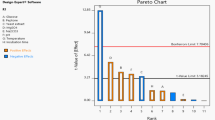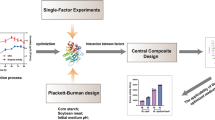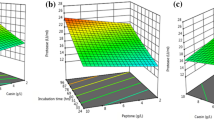Abstract
Bacterial proteases are considered potential candidates for industrial and biotechnological applications. In the present study, the influence of various parameters on an in-house isolated alkaline protease was investigated through central composite design from a well-known response surface methodology technique. A high level of alkaline protease productivity up to 8.9-folds was achieved from a novel strain of Bacillus subtilis isolated from local Tannery, Lahore Distt. (Pakistan). The purification profile revealed 8.48-fold increase to homogeneity by ammonium sulfate fractionation and Sephadex G-100-based gel filtration chromatography. The purified fraction was identified as a monomeric with apparent molecular weight of 15 kDa on sodium dodecyl sulfate–polyacrylamide gel electrophoresis. The catalytic characterization was performed with various substrates using Michaelis–Menten equation. The alkaline protease remained optimally active within a broader pH range of 8–12 having a half-life of 37.8 min at 87 °C, along with a maximum velocity (Vmax) of 200 IU/mL/min and 0.090 mg/mL Michaelis constants. Moreover, a complete de-staining and dehairing were recorded within the short incubation period. In conclusion, the data thus obtained in this study suggest a high potential for enzymatic treatment in an industrial setting.
Graphical Abstract









Similar content being viewed by others
References
Naidu KSB, Devi KL (2005) J Biotecnol 4:724–726
Geethanjali S, Subash A (2011) World J Fish Mar Sci 3:88–95
Rathakrishnan P, Nagarajan P, Kannan RR (2012) Int J Chem Tech Res 4:749–760
Joo HS, Kumar CG, Park GC, Paik SR, Chang CS (2002) Proc Biochem 38:155–159
Ahmed I, Zia MA, Iftikhar T, Iqbal HMN (2011) BioRes 6(4):href="tel:4505–4522">4505–4522
Kamal S, Rehman S, Iqbal HMN (2016) Environ Prog Sust Energy. doi:10.1002/ep.12447
Betty AF, Daniel FS, Alice SW (2002) Bailey and Scott’s diagnostic microbiology. 11th Ed. Mosby Inc, St. Louis.
Babu SI, Srinu BG, Kumar KN, Kumari SK, Yugandhar MN, Raju K (2005) Int J Chem Sci 4:951–958
Bradford MM (1976) Anal Biochem 72:248–254
Zambare V, Nilegaonkar S, Kanekar P (2010) IIOAB J 1(4):18–21
Asgher M, Aslam B, Iqbal HMN (2013) Chin J Catal 34(9):1756–1761
Bilal M, Asgher M, Iqbal HMN, Hu H, Zhang X (2016) Catal Lett 146(11):href="tel:2221–2228">2221–2228
Asker MMS, Manal GM, Khalid ES, Mohamed SAA (2013) J Gene Eng Biotechnol 11:103–109
Krishnaveni K, Mukeshkumar DJ, Balakumaran MD, Ramesh S, Kalaichelvan PT (2012) Der Pharmacia Lett 4:98–109
Lakshmi G, Prasad NN (2015) Adv Biol Res 9:15–23
Iqbal HMN, Asgher M, Bhatti HN (2011) BioRes 6(2):1273–1287
Palsaniya R, Mishra R, Beejawat R, Sethi S, Gupta BL (2012) J Microbiol Biotechnol Res 2:858–865
Iqbal HMN, Kyazze G, Keshavarz T (2013) BioRes 8(2):href="tel:3157–3176">3157–3176
Madhavi J, Srilakshmi J, Raghavendra MVR, Sambasiva KRSR (2011) Int J Biosci Biotechnol 4:11–26
Padmapriya M, Williams BC (2012) J Microbiol Biotechnol Res 2(4):612–618
Silva CRD, Delatorre AB, Martins MLL (2007) Braz J Microbiol 38(2):253–258
Wilson P, Remigio Z (2012) Afr J Microbiol Res 27:href="tel:5542–5551">5542–5551
Kaur M, Dhillon S, Chaudhary K, Singh R (1998) Ind J Microbiol 38(2):63–67
Thangam EB, Rajkumar GS (2002) Biotechnol Appl Biochem 35(2):149–154
Jaswal RK, Kocher GD (2007) Internet J Microbiol 4(1):162–166
Kanekar PP, Nilegaonkar SS, Sarnaik SS, Kelkar AS (2002) Biores Technol 85(1):87–93
Acknowledgements
This article is based on “Kinetic study and industrial application of protease” funded by Higher Education Commission of Pakistan (PM-IPFP/HRD/HEC/2012/3556). The financial support provided by HEC is thankfully acknowledged.
Author information
Authors and Affiliations
Corresponding author
Ethics declarations
Conflict of interest
The authors declare that they have no conflict or competing interests.
Rights and permissions
About this article
Cite this article
Hussain, F., Kamal, S., Rehman, S. et al. Alkaline Protease Production Using Response Surface Methodology, Characterization and Industrial Exploitation of Alkaline Protease of Bacillus subtilis sp.. Catal Lett 147, 1204–1213 (2017). https://doi.org/10.1007/s10562-017-2017-5
Received:
Accepted:
Published:
Issue Date:
DOI: https://doi.org/10.1007/s10562-017-2017-5




